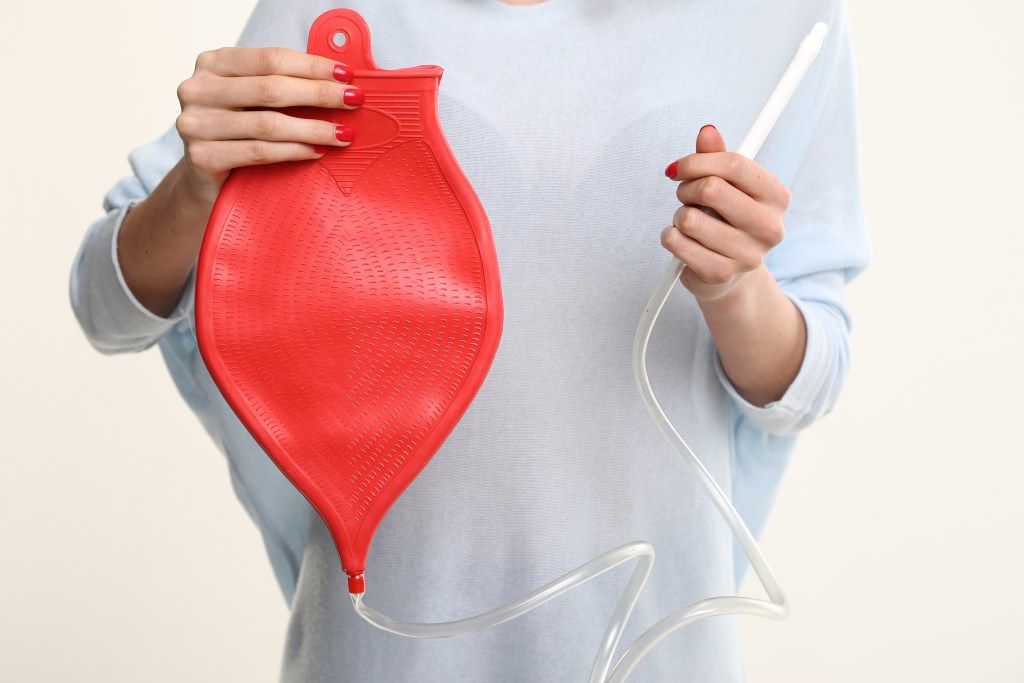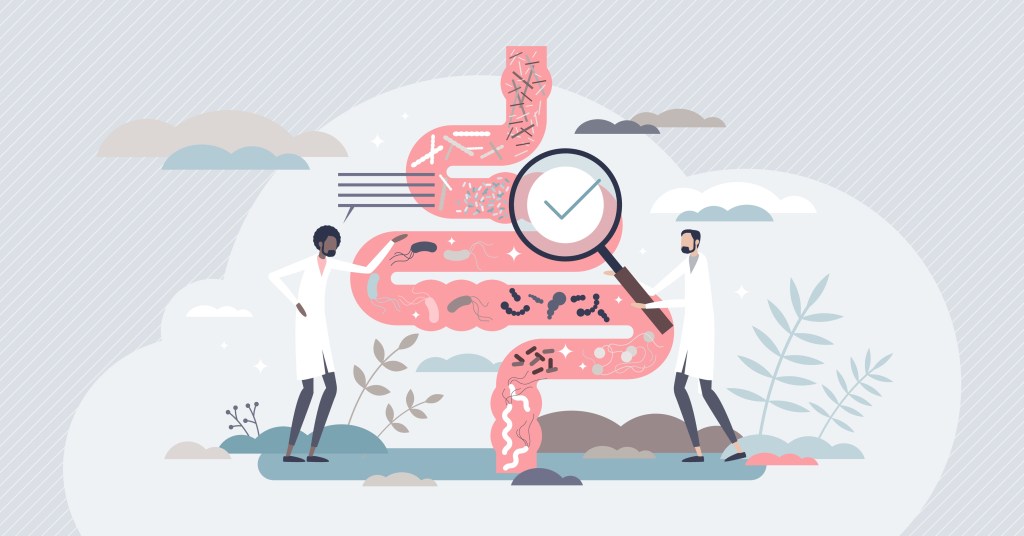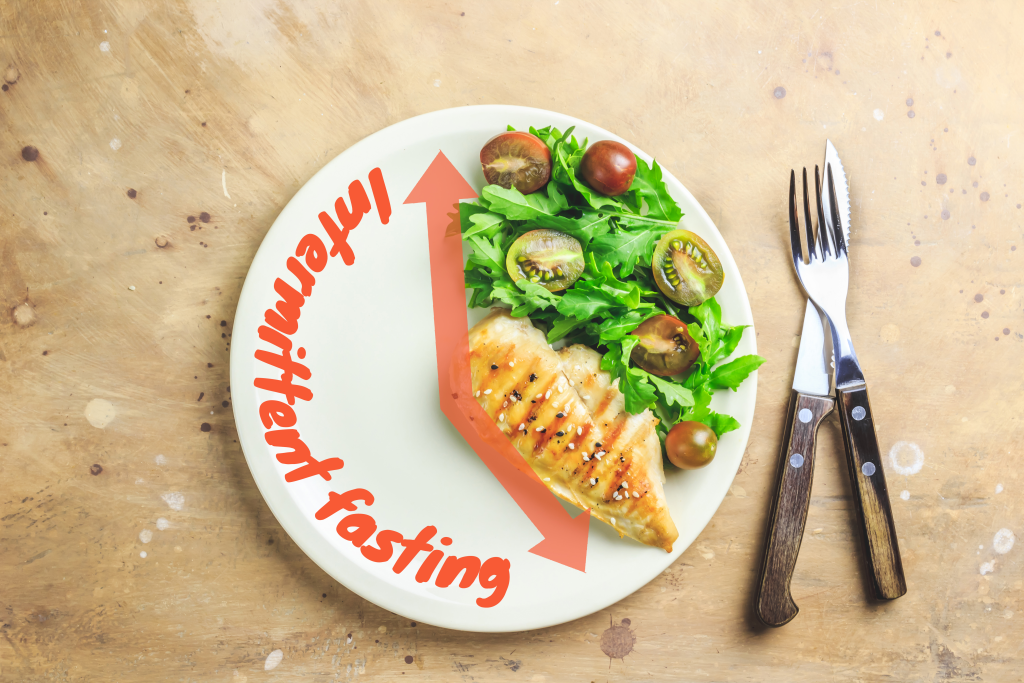Certain colon cleanse providers claim that adults can have between 5 and 20 pounds of toxic poop in their gut, supposedly causing issues such as weight gain, fatigue, and brain fog.
However, scientific evidence doesn’t support this myth, as the body’s natural detoxification and elimination processes effectively manage waste without the need for extreme cleansing.
Discover the steps you can take to support healthy bowel movements and explore how making beneficial dietary and lifestyle changes can significantly improve your gut health.
Do you have 5 to 20 pounds of toxic poop in your colon?
Advocates of colon cleanses often warn about the dangers of toxic poop, with some claiming that people can have as much as 20 pounds of stool backed up in their colon.
While some individuals experience sluggish digestion or constipation, the reality is that most people don’t retain such a large amount of stool.
On average, most people eliminate about 14 to 16 ounces of stool daily, making an accumulation of 20 pounds very unlikely.
Even in individuals with constipation or poor dietary habits, it’s highly unlikely that such a significant buildup of stool accumulates in the colon.
However, in some cases, those with severe constipation or certain medical conditions may experience impacted stool. This can lead to significant discomfort and poor waste removal, affecting detoxification pathways and overall well-being.
Watch the video below to learn why it’s unlikely you have 5 to 20 pounds of toxic poop.
What is toxic poop?
Toxic poop or toxic waste are terms often used to describe fecal matter that has accumulated and impacted along the colon walls.
While it’s rare for healthy individuals to accumulate 5 to 20 pounds of waste in the colon, certain inflammatory conditions can lead to a buildup of harmful substances in the gastrointestinal tract.
While toxic poop is largely a myth, poor dietary and lifestyle habits, as well as certain health issues, can create an unhealthy digestive environment.
Poor gut health can cause symptoms such as constipation and poor elimination of waste, which can increase the reabsorption of potentially harmful and toxic compounds that were supposed to be eliminated.
What is a toxic megacolon?
While toxic poop is more of a marketing term, a toxic megacolon is a serious medical condition characterized by extreme dilation and inflammation of the colon.
This condition often occurs as a complication of inflammatory bowel diseases, such as ulcerative colitis or Crohn’s disease, but can also result from infections or certain medications.
In rare cases, esophageal and intestinal blockages can contribute to a toxic megacolon, as they may lead to a buildup of pressure and inflammation in the colon, exacerbating the condition.
Toxic megacolon can cause severe pain, and the large intestine can become completely blocked, creating a dangerous buildup of gas and feces.
Immediate medical intervention is required, as this condition can lead to colon rupture and life-threatening complications if left untreated.
Treatment typically involves addressing the underlying cause and, in some cases, surgery to remove the affected portion of the colon.
Research published in Inflammatory Bowel Diseases summarizes, “Toxic megacolon represents a dreaded complication of mainly inflammatory or infectious conditions of the colon. The main characteristics are signs of systemic toxicity and severe colonic distension.”1

Toxic megacolon risk factors and symptoms
Several factors can increase the risk of developing a toxic megacolon, and recognizing its symptoms early is crucial for effective treatment.
Risk factors associated with toxic megacolon include:
- Ulcerative colitis
- Crohn’s disease
- Colon infections, particularly Clostridium difficile
- Reduced blood flow to the colon
- Colon cancer
Evidence published in Clinical and Experimental Gastroenterology found that a recent diagnosis of irritable bowel disease (IBD) significantly increases the risk of toxic megacolon.2
IBD is characterized by chronic inflammation of the colon and abnormal intestinal contractions, which can lead to waste impaction and blockages, further increasing the likelihood of this serious condition.
Common symptoms of toxic megacolon include:
- Severe colon inflammation
- Intense abdominal pain
- Abdominal distension
- Fever
- Rapid heart rate
- Dangerously low blood pressure
- Dehydration
- Altered mental status
Complications of toxic megacolon can be life-threatening and include colon perforation, severe bleeding, sepsis, and shock.

Are colon cleanses healthy?
Harsh colon cleansing methods, such as colonic irrigation and extreme dietary cleanses, can flush out beneficial gut bacteria, disrupting healthy digestion and weakening immune system function.
Popular colon cleanser products may promise quick detoxification but can pose significant risks to your digestive health.
It’s important to recognize the dangers of colonic irrigation and other colon cleanser routines. In most cases, colonics aren’t recommended for detoxification, and if done improperly, can lead to infections, anal fissures, electrolyte imbalances, and dehydration.
In addition, colon cleansing products can flush out beneficial bacteria. This disrupts microbial gut diversity and can lead to significant intestinal flora changes, impacting digestive functions and overall gut health.
Research published in the American Journal of Gastroenterology confirms this, highlighting that scientific evidence doesn’t support colonic cleansing’s effectiveness or safety.3

How gut microbes affect digestion
Gut microbes play a vital role in digestion and overall health, supporting many essential functions in the body, including immune system regulation and defense against infections.
Key functions of gut microbes include:
- Breaking down and fermenting food for nutrient absorption
- Assisting the body in converting food into essential nutrients
- Preventing the overgrowth of harmful microbes
- Promoting a healthy intestinal environment
- Supporting immune system health
- Aiding in the defense against infections
A balanced gut microbiome, which consists of trillions of bacteria, fungi, and other microbes, is essential for maintaining a healthy digestive system.
Dietary and lifestyle choices significantly influence the diversity of beneficial microbes in the digestive tract. Maintaining a healthy microbiome is crucial for digestive health, immunity, and overall well-being.
Factors that can reduce microbial diversity include:
- Frequent eating and overeating
- High sugar and processed food intake
- Antibiotic use
- Alcohol consumption
- Consumption of artificial sweeteners
- Being overweight or obese
- Chronic stress
- Certain medications
- Exposure to environmental toxins

7 ways to cleanse your colon naturally
Colon cleanses may pose a risk to gut health and overall well-being. However, there are various steps you can take to promote microbial diversity, support detoxification processes, and maintain healthy bowel movements.
Here are seven ways to cleanse your colon naturally.
1. Incorporate probiotic-rich foods
Probiotic-rich foods such as kefir, sauerkraut, kimchi, tempeh, and kombucha may help promote a healthy balance of gut bacteria.
Certain probiotic strains, such as Lactobacillus and Bifidobacteria, are commonly associated with digestive health and may support overall gut function, and adding these foods to your diet can be a great way to support digestive wellness.
2. Increase intake of prebiotics
Prebiotics are a type of dietary fiber that nourishes beneficial gut bacteria, helping them thrive and proliferate.
Onions, garlic, non-starchy vegetables such as asparagus, leeks, and spinach, as well as nuts and berries, are excellent sources of prebiotic fibers and help support a balanced and healthy gut microbiome.
A study published in Trials highlights the digestive health benefits of prebiotic foods, showing that individuals with a high intake of prebiotics tend to have more regular bowel movements and a reduced risk of both constipation and diarrhea.4

3. Reduce stress
Chronic stress can contribute to various digestive disorders, including IBD, increasing the risk of a toxic megacolon.
Stress-related hormones have also been found to promote the growth of harmful gut bacteria, weaken the gut barrier integrity, and impair waste elimination.
By managing stress effectively, you can help support a healthier gut microbiome, which in turn aids in natural colon cleansing and overall digestive health.
4. Follow a Healthy Keto® diet
A Healthy Keto® diet helps support natural colon cleansing by focusing on nutrient-dense, low-carb foods that promote gut health.
By eliminating high-sugar, processed foods that can disrupt the balance of gut bacteria, Healthy Keto supports a more balanced and diverse microbiome.
This nutritious low-carb diet also prioritizes prebiotic vegetables, fermented foods, and healthy fats, all of which support regular bowel movements, reduce inflammation, and help maintain optimal digestive system functions, contributing to overall colon health.

5. Practice intermittent fasting
The body isn’t designed for constant eating, and continuous food intake can overwhelm the digestive tract, leading to malabsorption and incomplete digestion.
Intermittent fasting allows the body to rest and focus on eliminating waste more efficiently.
Giving your digestive system extended periods without food helps clear out undigested material and supports better digestion, ultimately promoting more effective waste elimination.
6. Prioritize optimal hydration
Both dehydration and overhydration can impact digestion and bowel movement regularity.
Inadequate hydration can lead to dehydration, electrolyte imbalances, and constipation, while overhydration may flush out essential electrolytes needed for healthy colon function.
It’s important to listen to your body, drink when you’re thirsty, and avoid consuming more fluids than your body needs.
7. Exercise regularly
Exercise supports colon health by improving bowel motility, which promotes regular bowel movements and helps prevent constipation.
Physical activity also reduces stress, which can negatively impact digestion, and boosts circulation, ensuring the digestive organs function efficiently.
Additionally, regular physical activity supports a healthy gut microbiome, enhancing digestion and waste elimination.

Key takeaways
The idea of toxic poop is largely a myth, often used as a marketing tactic to promote colon cleanses.
For most people, colonic cleansing is unnecessary and may even be harmful, as it can disrupt the balance of beneficial gut bacteria, lead to electrolyte imbalances, and increase the risk of infections.
Supporting your digestive health through proper nutrition, staying hydrated, managing stress, and exercising regularly are the most effective ways to maintain a healthy and optimally functioning colon.
FAQs
1. Can poop poison you?
In most cases, the stool moving through your large intestine isn’t toxic and won’t harm you while it’s in your colon.
However, in rare instances, a serious condition called toxic megacolon may occur, which is characterized by intestinal blockage and severe abdominal distention, requiring immediate medical attention.
2. How do I do a colon cleanse?
The most effective way to support your colon health is through a balanced diet and healthy lifestyle choices.
A well-rounded approach that includes staying hydrated, managing stress, eating nutrient-rich foods, and staying physically active can help keep your digestive system functioning optimally.
3. Are your bowels ever completely empty?
Your bowels are never completely empty, as there is always some residual waste in the digestive tract. However, regular bowel movements help clear the majority of waste and maintain digestive health.
4. How much toxic poop is in your body?
The idea that you have toxic poop stuck in your body is a myth. Except in extremely rare cases, there’s no buildup of harmful waste in your colon.
Poop is a natural byproduct, and your digestive system effectively eliminates it as needed. Even occasional constipation doesn’t mean you have 5 to 20 pounds of toxic waste trapped in your colon.
5. How do I get rid of toxic poop with colon cleansing?
The concept of toxic poop is inaccurate, and there’s no need for colon cleansing procedures to flush out your stool.
Instead, focus on maintaining a healthy diet, staying hydrated, and exercising regularly to naturally support healthy digestion and bowel movements.
6. What does toxic megacolon poop look like?
The appearance of stool associated with a toxic megacolon varies depending on the underlying cause and may take on a greenish or black color instead of the usual brown.
In severe cases, a toxic megacolon can lead to the formation of hard, impacted fecal masses known as fecalomas.
7. What is a colonic?
A colonic is a procedure where a hygienist inserts a tube into the rectum to introduce water into the colon, flushing out feces.
While it may be marketed as a detox method, colonics are unnecessary and ineffective for maintaining a healthy colon or managing conditions such as inflammatory bowel disease (IBD).
Sources
- https://pubmed.ncbi.nlm.nih.gov/22009735/ ?
- https://pmc.ncbi.nlm.nih.gov/articles/PMC7245441/ ?
- https://pubmed.ncbi.nlm.nih.gov/19724266/ ?
- https://pmc.ncbi.nlm.nih.gov/articles/PMC10996211/ ?







